I was never quite keen on visiting cemeteries. In fact, I remember as a kid, I would always dread going to the few cemeteries to pay respects to my departed elders. They were always overgrown with plants, ridden with mosquitoes, hot and the many graves and plants made it difficult to move around in.
However, when Gilbert invited Boon Hwee and I for a walk to Bukit Brown, I decided to put all my apprehension aside. The Bukit Brown Cemetery was in the news lately as the government has decided to go ahead with building an 8-lane expressway across it, thereby eradicating a great many graves, many of which hold significance in Singapore’s history and heritage.
The cemetery was named after the first owner, George Henry Brown, a ship owner who arrived in Singapore from Calcutta in 1840s. The site was made into a municipal cemetery in 1922 let by committee leaders Tan Kheam Hock and See Tiong Wah.
Interestingly, cemetery was also known as Kopi Sua (Coffee Hill) by the Chinese. This was apparently referring to the coffee-coloured soil of the hill it’s on, and not so much about coffee being planted there.
On arriving at the cemetery, I discovered that it was actually a quiet and peaceful place, filled with lush greenery which reminded me of the KTM Rail Corridor which I have visited last year. It’s also one of the last few places in Singapore which modernisation has not taken over. But this won’t be for long, hence the formation of multiple groups lobbying for its preservation.


A little beyond the moss-encrusted wrought-iron gates is a large raintree which is affectionally known as “The Ole Rain Tree” by the conservationists from the Bukit Brown Facebook group and their recently-launched blog. The enthusiasts gather under the tree every weekend to spread awareness of the place as well to collect signatures for a petition to save the Bukit Brown Cemetery.

Beyond this, the lush greenery is evident all around, and being an isolated area, away from the hustle and bustle of the city, there is a sense of peace and quiet. People can be seen strolling, cycling, jogging and even riding a horse in the compound.



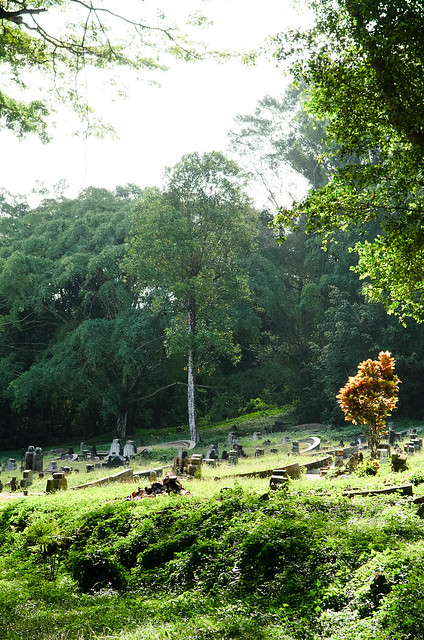
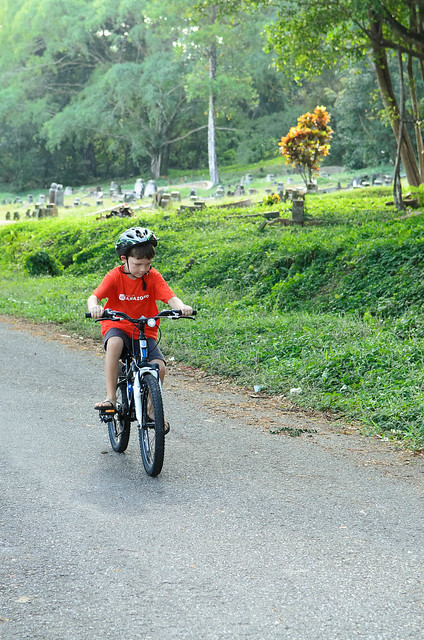


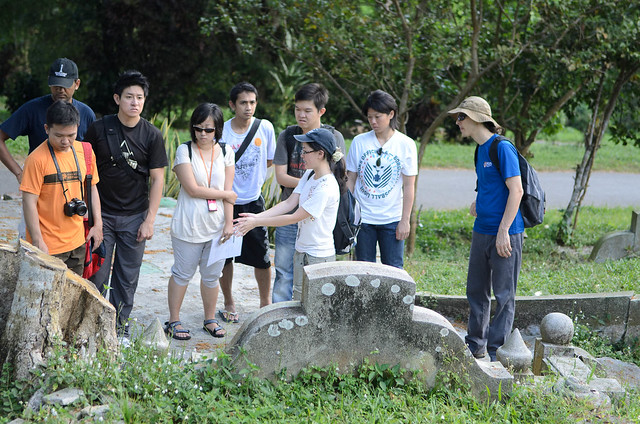
Near the entrance is a cluster of tombstones, and one of them actually had a gate. This was probably owned by one of the more well to do families who had the funds to build additional features such as these for their tombstones.

We had originally intended to locate the more prominent graves using the map provided on the Asia Paranormal Investigators‘ (API) website, but unfortunately some of the markers they have kindly placed have dropped off (or removed) over time and we cannot reliably locate them any more. So we decided to just take a leisurely stroll instead.
Ignoring that fact that this is actually a cemetery, it actually feels like strolling in a big nature park, at least in the day time.




Before long, we stumbled into an API sign leading us to the tombstone of Ong Sam Leong, the largest in the cemetery.
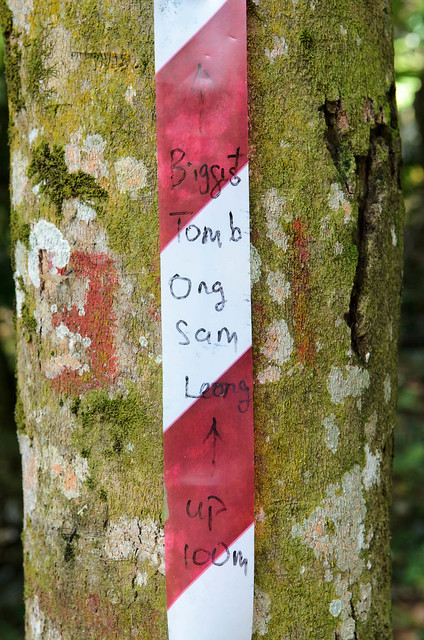
We decided to check it out and after a short hike, we arrived at the tombstone.
Spanning an area equivalent to ten (!) 3-room HDB flats, it’s the biggest tombstone in the Bukit Brown Cemetery. It was elaborately decorated with floral tiles, bas-relief carvings, stone lions, sikh guards and there was even a moat with fish around it in the early days. The moat has since dried up but the sheer size is still impressive.
Here is a panoramic view of it. Click on the image for a larger version.

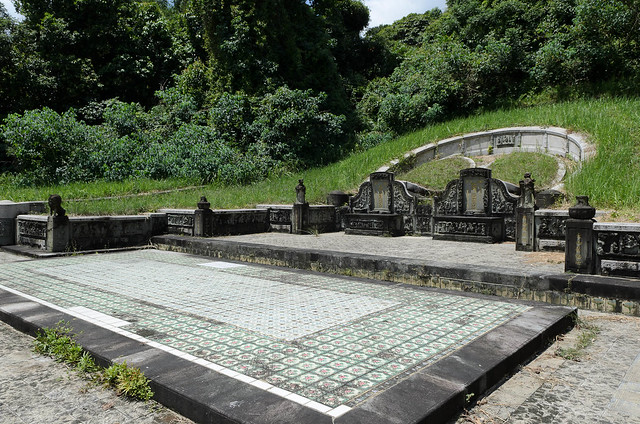





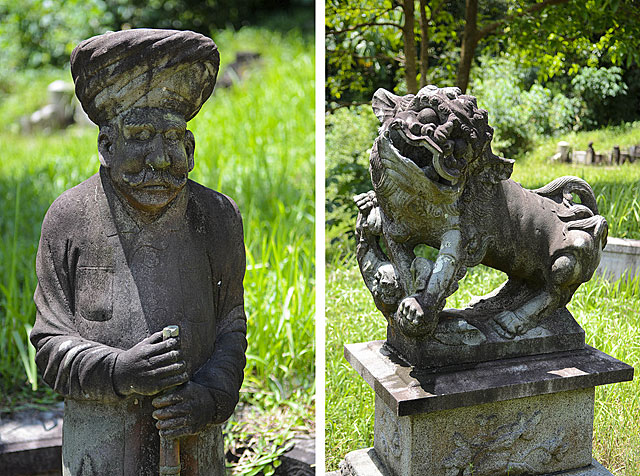
On the way back to the entrance, we came across this rather interesting tomb and its Sikh guard statues. Unlike the others we’ve seen, this pair was painted in colour.

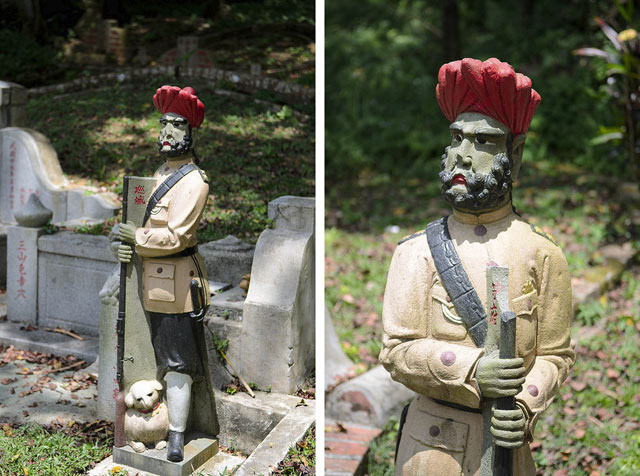
At this point, we were tired and hungry and wanted to call it a day. However, we ran into Tien who was collecting signatures of a petition under the Ole Rain Tree. Out of curiosity, Gilbert asked about an abandoned temple nearby. We got directed to Mr. Raymond Goh, one of the founders of the API who got very excited and enthusiastic and started an impromptu tour to the temple. This is to be our next adventure, but I’ll leave it for the next blog post.
Meanwhile, please show your support for the preservation of the Bukit Brown Cemetery over at the Facebook Group and blog. You can also share your experiences and photos if you’ve visited the place with the others at the group and blog.
For more photos of my walk, do check out my Flickr set.
Hi, your pictures are really nice and they really increase my knowledge of Bukit brown cemetery!
I have actually some questions that i would like to ask you. Do you know what does the two colours of tiles that cover the courtyard of ong sam leong tombstone signifies or represent?
As well as the sik guards and stone lions statues.
Thanks a lot! 🙂
Hope to hear from u soon!
Cheers!
Thanks Yanying. Regarding the two-colored tiles, it’s because some have been replaced recently with newer (whiter) ones. I don’t know much about the rest, I’m as new as you are to Bukit Brown. You can visit the All Things Bukit Brown blog and click on “Ask Raymond”. He’s the expert on Bukit Brown and should be able to answer your question.
My maternal grandparents lived in the kampong somewhere in Bt Brown.I remember the place is called Jalan Wayang Satu or Lorong Halwa? It was like in a valley. From the back of their house we could climb up a hill and could see the cemetery. But I never know there is such grand entrance to the cemetery.
The kampong has since been evacuated and demolished and I could not remember how to get in as I was quite young and only follow my parents when we visited my grannies.
Do you know how I could access the said place?
Hi CH,
I am not familiar with the place, so I posted your question to the Bukit Brown Facebook group to see if anyone else knows. You might want to join the group too, and to post any other questions you may have.
Regards
CK
Thanks for sharing your photos and the valuable information in the website.
I know that the highway will be build across Bukit Brown but I still not too sure which areas are affected. Hope that we can still cherish it while everything is still here.